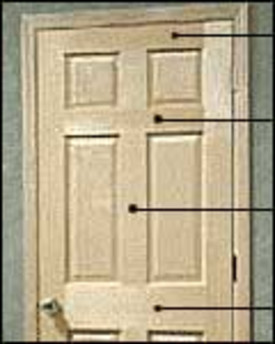 Typical elements of a raised panel interior door. |
Doors do more than open and close. There are part of a home’s décor, a buffer between one space and the next. It stands to reason, then, that door purchases should weigh heavily in the home construction budget.
Door Form and Function
A door, whether it is solid, glass, louvered, or half glass, should complement the surrounding décor, and ornament the wall on which it lives. At the very least, the style of the door should complement existing accents like moldings and trim. A raised panel wood door finished in a natural stain is a bold accent when fitted into painted trim. Homeowners typically choose stained wood doors to complement stained trim, painted doors to accent painted trim. Mixing these styles brings great attention to both, and places great focus on the door, its styling, and finish.
Doors create buffer one space from the next. Like walls, doors need to be insulated to protect against sound transfer. If sound buffering is important, as for bedrooms and offices, a solid-core door is the best solution. Too often homeowners get to the end of the project and opt for less-expensive doors. While they may have budgeted for sound-deadening insulation or panels in the walls, they often opt for less expensive doors to complete those walls. Hollow-core doors allow sound to enter, defeating the hard-won sound insulation in the walls or floor. “Homeowners forget about budgeting for doors early, and they compromise” says Jim Daniels, national sales and marketing manager for Woodport Doors. Since homeowners rarely replace doors, it’s best to think about them early on. “You’ll look at them forever,” Daniels says.
Door Types
The great housing boom after World War II brought with it the advent of hollow-core doors. Hollow-core doors are made from two thin veneer plywood or hardboard faces. Between the two are supports, often made of cardboard, to help keep the door rigid. These doors are light, inexpensive, prone to puncture, and ineffective as sound barriers. Still, they provide a flush face for paint or stain, are easily installed or replaced, and fit into the most modest of budgets. As these houses were purchased and renovated, it became evident to builders and homeowners that an affordable alternative to hollow-core doors was needed. Finding an affordable, well constructed, and beautiful solid core door became an industry-wide quest as the renovation market took off in the late 1970s and 1980s.
At first, door makers attempted solid wood doors made of young oak and pine in an effort to supply high market demand for a moderately priced solid-core door. “They’d dry, cup, and crack,” Daniels says, “and they were too expensive compared to a $30 hollow-core flush door.” High-quality wood doors were and are an investment in excellence and craftsmanship, an investment that is beyond many homeowners. Solid wood doors must be kiln and air dried to prevent warping or cracking. Joints must be manufactured to withstand stress. They are not budget sensitive.
Engineered Wood Doors
So the industry came up with engineered wood cores, faced with high-quality wood veneers. Some manufacturers carry solid core doors made from high-density fiberboard or hardboard. A top-quality engineered-core door may be constructed with hardwood sticking—the pieces that go between the panels, to the sides, and below—called the stiles and the rails. Some manufacturers edge their panels in hardwood where they meet the sticking. A top-quality solid-core door will also have hardwood support where screw holes are located for good adhesion without stripping. These doors, like solid wood doors, come in raised panel and flat-panel styles. They can be stained or painted, but typically have veneered faces that are suitable for staining.
Another option is solid medium-density-fiberboard (MDF) doors and moldings. MDF is an engineered wood product that is produced in sheets and then milled like hardwood. It is extremely dense, with a tight, flat surface. It is suitable only for paint, but gives a flatter painted surface than wood. Its sound insulation is superior, and MDF can be milled to any profile. “MDF is a very versatile product,” says Daniels. It is an easy-to-finish, affordable alternative to solid wood doors.
Practical Advice
Doors are a substantial portion of any building or remodeling project. While it may break the bank to spend 300 dollars per door, there may be areas of the home that need high-quality profiles, finishes, durability, or sound-deadening qualities. First determine which doors have a decorative function in the home. Select a door that will complement the furniture, moldings, and style of the rooms. Determine whether these doors need to be wood, wood surfaced, or paint grade, then budget accordingly. Next evaluate which rooms require doors with sound-deadening capabilities. Again determine whether they need a natural wood face or whether a stain-grade product would serve as well. Finally, decide which doors are strictly utilitarian and can be served by flush or hollow-core doors. This approach will help you determine how to best budget for the doors in your home while making a decision you can really live with.
Credit: Renovate Your World




























